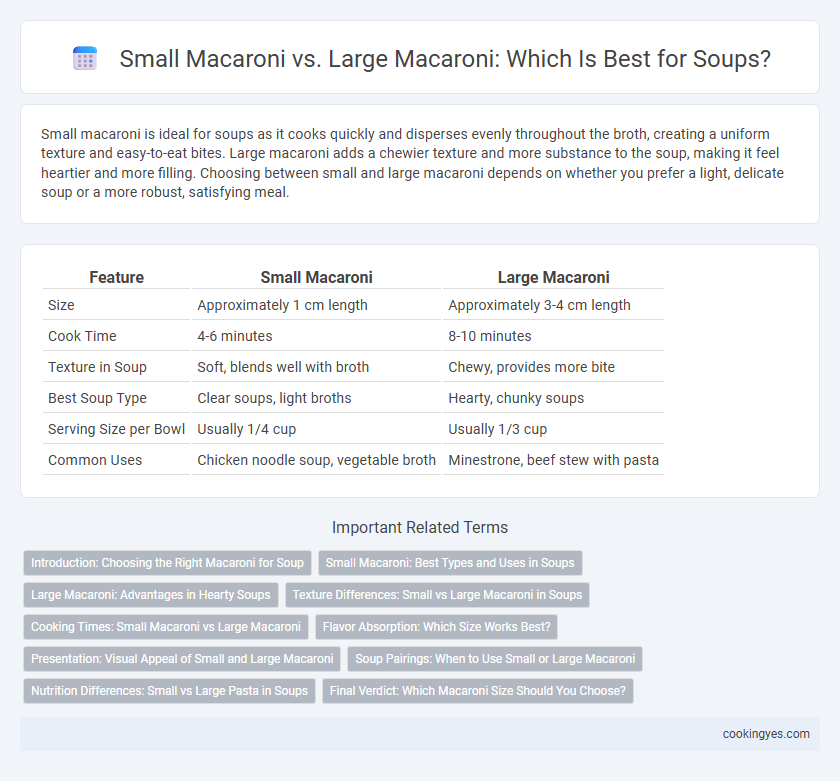Small macaroni is ideal for soups as it cooks quickly and disperses evenly throughout the broth, creating a uniform texture and easy-to-eat bites. Large macaroni adds a chewier texture and more substance to the soup, making it feel heartier and more filling. Choosing between small and large macaroni depends on whether you prefer a light, delicate soup or a more robust, satisfying meal.
Table of Comparison
| Feature | Small Macaroni | Large Macaroni |
|---|---|---|
| Size | Approximately 1 cm length | Approximately 3-4 cm length |
| Cook Time | 4-6 minutes | 8-10 minutes |
| Texture in Soup | Soft, blends well with broth | Chewy, provides more bite |
| Best Soup Type | Clear soups, light broths | Hearty, chunky soups |
| Serving Size per Bowl | Usually 1/4 cup | Usually 1/3 cup |
| Common Uses | Chicken noodle soup, vegetable broth | Minestrone, beef stew with pasta |
Introduction: Choosing the Right Macaroni for Soup
Small macaroni shapes like elbow or ditalini are ideal for soups due to their bite-sized pieces that blend well with broth and other ingredients. Large macaroni varieties such as rigatoni or shell add a hearty texture but may overpower delicate soup flavors or require longer cooking times. Selecting the appropriate macaroni size enhances mouthfeel and ensures balanced cooking, making small macaroni preferable for light, clear soups and large macaroni suited for chunky, thicker varieties.
Small Macaroni: Best Types and Uses in Soups
Small macaroni varieties such as elbow macaroni, ditalini, and orzo are ideal for soups due to their quick cooking times and perfect bite-sized shape that blends well with broth and ingredients. These small pasta types absorb flavors efficiently, creating a balanced texture without overpowering the soup. Their versatility enhances classic soups like minestrone, chicken noodle, and vegetable chowders, providing a satisfying mouthfeel and optimal portion control.
Large Macaroni: Advantages in Hearty Soups
Large macaroni provides a robust texture that holds up better in hearty soups compared to small macaroni varieties. Its increased surface area allows it to absorb rich broth flavors effectively, enhancing the overall taste experience. This makes large macaroni an ideal choice for thick, chunky soups where pasta needs to complement substantial ingredients without becoming mushy.
Texture Differences: Small vs Large Macaroni in Soups
Small macaroni provides a tender, uniform texture that disperses evenly throughout soups, enhancing each spoonful with consistent, bite-sized pasta pieces. Large macaroni offers a chewier, heartier mouthfeel, creating a more substantial presence that contrasts with softer soup ingredients. The choice between small and large macaroni impacts the overall soup experience by balancing the interplay of pasta texture and soup consistency.
Cooking Times: Small Macaroni vs Large Macaroni
Small macaroni cooks significantly faster, typically requiring 5 to 7 minutes, making it ideal for quick soups and broths where even texture is desired. Large macaroni, with its thicker walls and larger size, needs 10 to 12 minutes to achieve a tender bite, suitable for heartier, chunkier soups that benefit from a more substantial pasta presence. Choosing the appropriate macaroni size is essential to match cooking times with soup consistency and desired texture.
Flavor Absorption: Which Size Works Best?
Small macaroni absorbs broth and spices more effectively due to its increased surface area relative to volume, enhancing the soup's overall flavor profile. Large macaroni tends to hold more liquid internally but may not distribute the soup's taste as evenly throughout each piece. For maximizing flavor absorption, small macaroni is generally preferred in soups where a consistent, rich taste is desired.
Presentation: Visual Appeal of Small and Large Macaroni
Small macaroni enhances soup presentation by creating a delicate, finely textured appearance that allows broth and vegetables to remain visually prominent, ideal for clear or light soups. Large macaroni offers a bold, chunky aesthetic, making the soup look heartier and more substantial, which is perfect for thick and creamy varieties. The choice between small and large macaroni significantly influences the visual appeal, affecting the perceived richness and style of the dish.
Soup Pairings: When to Use Small or Large Macaroni
Small macaroni, such as elbow or ditalini, pairs well with light broths and vegetable-based soups due to its ability to evenly distribute throughout the spoonful, enhancing texture without overpowering other ingredients. Large macaroni varieties, like rigatoni or large shells, are better suited for hearty, thick soups like minestrone or beef stew, where their size holds up to substantial chunks of meat, vegetables, and robust flavors. Choosing the appropriate macaroni size improves the overall balance and mouthfeel of the soup, ensuring each bite delivers a harmonious blend of pasta and broth.
Nutrition Differences: Small vs Large Pasta in Soups
Small macaroni absorbs broth more efficiently due to its higher surface area-to-volume ratio, enhancing flavor with fewer calories per serving. Large macaroni contains more carbohydrates and protein per piece, providing greater energy density but potentially increasing soup heaviness. Nutritionally, small macaroni offers a lighter option for calorie control, while large macaroni delivers more substantial protein and carbohydrate content for heartier soup meals.
Final Verdict: Which Macaroni Size Should You Choose?
Small macaroni is ideal for soups due to its ability to blend seamlessly with broth and evenly disperse flavor, enhancing each spoonful without overpowering the dish. Large macaroni, while suitable for thicker soups and stews, can dominate the texture and alter the soup's balance. For a light, well-integrated soup experience, small macaroni is the preferred choice.
Small macaroni vs Large macaroni for soups Infographic

 cookingyes.com
cookingyes.com